
In this issue I want to update you on actions taken last Friday at the Board of Governors meeting and the budget assumptions for the 2013 budget.
Board of Governors actions
At the Oct. 28 meeting the Board of Governors took action on three important initiatives that have been in process for a period of time, from several months to several years.
The Board enthusiastically approved the mid-year salary package as proposed and as presented in the October issue of Clif’s Notes. In December we will ask for the Board’s approval of the individual raises for employees, with the raise to go into effect on Jan. 1, 2012, for staff and Feb. 1, 2012, for faculty.
Cooperative Doctor of Pharmacy Program
The Board officially ratified the memorandum of understanding we signed Oct. 14 with the University of Missouri-Kansas City and the MU System to offer a satellite site for UMKC’s Doctor of Pharmacy degree at Missouri State.
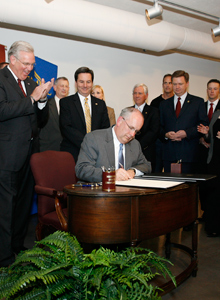 As you know, this cooperative program has been in the works for more than two years and was made possible this past legislative session with the approval of on-going funding. The PharmD program is a 2 + 4 format, with the first two years of requirements and prerequisites followed by the four-year professional program. The first class in the four-year professional program will enter in the fall of 2014, but students can start preparing now to apply for admission into the program.
As you know, this cooperative program has been in the works for more than two years and was made possible this past legislative session with the approval of on-going funding. The PharmD program is a 2 + 4 format, with the first two years of requirements and prerequisites followed by the four-year professional program. The first class in the four-year professional program will enter in the fall of 2014, but students can start preparing now to apply for admission into the program.
UMKC has decided to locate the PharmD program in building 1 of Brick City. Building 1, located at the corner of Campbell Avenue and Mill Street, is the largest of the buildings in Brick City. With UMKC as a partner, renovation of building 1 is now possible. The PharmD program will go into the 15,000 square feet on the fourth floor, and remaining units of the art and design department will go in the 45,000 square feet in the first three floors.
As you are aware, much of the art and design department is already in renovated buildings 3 and 4. And, with the Board’s action Friday, we also will renovate building 5 for the art and design department. Art and design should be able to move into its space in the fall of 2013 in both buildings 1 and 5, thus consolidating the entire department into Brick City. This also will free up space in Ellis Hall on campus and the Morris Center downtown that we desperately need for other functions.
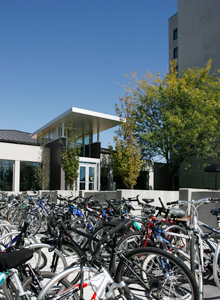 Residence hall renovations
Residence hall renovations
For about 15 years beginning in the late 1980s, Missouri State’s residence halls were among the best in the state and gave the University a competitive advantage in recruiting. But we have fallen behind in recent years. About two years ago a consultant was hired to help us develop a long-range plan to upgrade our residence halls. We are following many, but not all, of the consultant’s recommendations.
The first phase of that plan occurred this past summer when many of our residence halls got a facelift with new paint, new carpet, new drapes, new doors, etc. This week the Springfield Contractors Association is presenting an award to the University for the work that was done this summer, based on both the scope and the quality. Another round of upgrades to the residence halls is planned for summer 2012.
Also this past summer we razed two facilities: Dogwood Apartments and the Kentwood South apartments, which were the old motel-like apartments just south of Kentwood Hall.
On Friday the Board approved another step in this plan when it approved an architect to help us design a 300-bed apartment-style facility for upper class and graduate students. This facility will be located on Walnut Street just south of Kentwood Hall.
It is important to know that all of the improvements of residence halls are funded through the residence hall auxiliary fund. This is a planned fund that is built over the years through rental rates paid by students. No tuition dollars or state appropriations are used to operate or improve the residence halls. It is a self-sustaining auxiliary budget.
Other Board actions
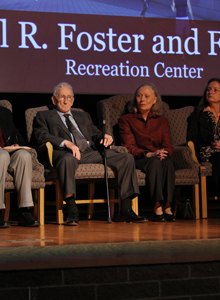 Naming of recreation center
Naming of recreation center
The Board officially named the new university recreation center the Bill R. Foster and Family Recreation Center in recognition of a naming-gift commitment from the Foster family. Mr. Foster is a Springfield businessman who works in the health care field. He and his entire family have a long history with Missouri State University. So, thanks to a dedicated student fee proposed and approved by the students themselves, along with private contributions from donors, the new 100,000-square-foot, $30 million Bill R. Foster and Family Recreation Center will open in March 2012.
New Intellectual Property Policy
The Board approved a new Intellectual Property Policy for the University, which is located in the policy library.
Diversity guidelines for contractors and vendors
Improving diversity continues to be a priority not only for Missouri State, but also for the City of Springfield, the Springfield Chamber and the entire Springfield community. Toward that end, several organizations in Springfield have agreed to take another positive step by adopting a set of diversity guidelines for working with contractors and vendors. Missouri State already does much of this under its own policies, as well as state law and policy, but we believed it was significant to renew and expand this commitment. The Board agreed and approved a resolution endorsing these guidelines which will soon be posted to the Missouri State website.
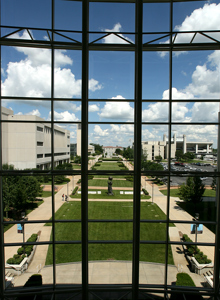 Fiscal year 2013 budget assumptions
Fiscal year 2013 budget assumptions
On Oct. 25 the Executive Budget Committee met to begin discussing the assumptions we will use in preparing the budget for fiscal year 2013. There are many specifics yet to determine over the coming three to four weeks, but I wanted to give you an update on the committee’s initial thinking.
The budget assumptions below represent our best estimates based on history, discussions with key individuals, and our own commitments as a university.
State appropriations – reduction of 5 percent ($3,583,667)
It is likely this is a worst case scenario, but we believe it prudent to plan for this level of reduction. We will know more in January and can adjust at that time if appropriate.
Enrollment – same as fall 2010
The committee felt a more aggressive approach to enrollment was warranted. In short, estimating flat enrollment from the actual for fiscal year 2011 (fall 2010) and budgeted for fiscal year 2012 means we must recapture the 226 students we lost in current fiscal year 2012 (fall 2011) to meet this projection. Said another way, it means moving from the current 22,866 back to 23,092.
Tuition increase – increase by 3.6 per cent ($3,348,558)
As you recall, absent a waiver, state law limits the tuition increase to the Consumer Price Index (CPI) from December to December. We estimate that CPI will be 3.6 per cent. We will have official notification of CPI in January and will finalize then. We do not intend to request a waiver to exceed CPI.
Other expenses – reallocate to fund more than $3.7 million of increases
We must reallocate for other increases, including a mid-year salary increase ($2,362,899), MOSERS increase ($522,290), University contribution to medical insurance (estimated at $907,710 based on current claims rate) plus utility increases and other fixed expense increases yet to be determined.
As I indicated, the Executive Budget Committee has several more weeks of work and at least a couple of meetings to determine more details for the assumptions. For example, the committee will discuss the level of reserves the University should maintain, if and how one-time funds should be used, if we can afford another modest across-the-board salary increase in July, etc. We will keep you informed as those assumptions are finalized.
Our goal is to provide enough guidelines for the various budget committees to begin their work with a specific goal in mind. Once we have the assumptions, each committee will be provided details about the targets.
Thanks for your continued involvement with the budget process. Working together, we can develop a sound financial plan for fiscal year 2013.
 Foundation’s All-University Campaign and United Way
Foundation’s All-University Campaign and United Way
Please accept my sincere thanks and gratitude for the campus response to two campus campaigns.
First, the Missouri State Foundation’s All-University Campaign was successful, topping the $182,000 mark with 20 percent participation, which is above the national average for large public institutions. These numbers will continue to grow as other faculty and staff members make gifts throughout the fiscal year.
Second, the United Way Campus Campaign total is at $101,687, which exceeds the goal for this year by more than $1,000 and is about $2,000 more than a year ago. This is a significant achievement that will help those in need in Springfield and Greene County. During the campaign a number of individuals joined the Leadership Circle of $500 or more; see the complete list of Leadership Circle members. The broadcast services unit won the grand prize for highest percentage participation at 67 percent, earning that group a reception at my home.
Again, I thank you for your generosity regarding two campaigns that make such a difference in the lives of our students and the lives of our friends and neighbors in the Ozarks.
Conclusion
As you read through this list of progress, please keep in mind how many people worked together to get us to this point.
- Chair Eric Bosch and the members of the Executive Budget Committee, along with the Administrative Council and good staff work from CFO Steve Foucart, positioned us for the mid-year salary increase and also the budget assumptions.
- Frank Einhellig, Pawan Kahol, Tammy Jahnke, Helen Reid, Joye Norris, Ken McClure, Dale Moore, Don Simpson and many others worked on the PharmD details.
- Earle Doman, Gary Stewart and many others in student affairs and residence life, along with Ken McClure, Doug Sampson and others in administrative and information services have been developing the detailed plan for our residence halls.
- Brent Dunn and the development staff get credit for helping with the naming gift and also for the campus campaign working with a campus steering committee of faculty, staff and administrators.
- The Faculty Senate Handbook Committee, working with a special task force chaired by Rebecca Woodward, an Intellectual Property Policy Committee chaired by General Counsel Penni Groves and the provost’s office developed the new Intellectual Property Policy.
- The United Way Planning Committee, headed by Marty Marty, deserves kudos for that success.
It is amazing what you can accomplish when you don’t care who gets the credit. Thanks to all for jobs well-done.
 –Clif
–Clif

When Iyshia Smith graduates in May 2012 with her early childhood education degree, she will not only teach students with her knowledge, she will inspire them with her personal story.
Even though she was salutatorian at Jennings Senior High in St. Louis, Iyshia Smith didn’t think college was an option; as one of five kids, college didn’t seem to be financially feasible for her and her single mom. Iyshia considered other options for herself after high school graduation, including the Army, but her mom was adamant that she needed to go to college.
Through the advisement of her guidance counselor she was encouraged to start applying for schools and scholarships. By December she had about 16 acceptance letters. She was so excited she hung the letters on the family’s Christmas tree. She narrowed her options down to three schools, including Missouri State University. To help her choose, each family member submitted their ballot for their favorite option.
“Everybody voted for Missouri State,” said Iyshia. “In June, I got the letter saying I got the Multicultural Leadership Scholarship. It was a done deal, then.”
Iyshia also received several other scholarships, including an academic scholarship and three donor-funded scholarships. She works in the Multicultural Resource Center and often speaks at recruitment events about how scholarship opportunities can make college possible for students.
This spring, Iyshia will complete her early childhood education degree by student teaching in an area Title I school, which she specifically requested. She chose this placement because she attended a Title I school and wants to work with underrepresented populations and educate about diversity.
“Kids that think they can’t do it because they don’t have any money,” said Iyshia. “Look at me. I came from a family with nothing, and I was able to go to school. I have hardly had to pay for anything for school because I have so many people in my corner rooting me on, saying, ‘Okay. You need some help? We’re going to try and get you some help. These are the scholarships you can apply for.’”

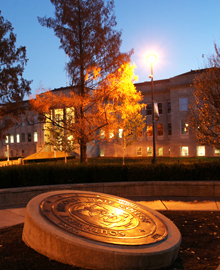

 Student learning outcomes initiative to continue
Student learning outcomes initiative to continue Sincerely,
Sincerely,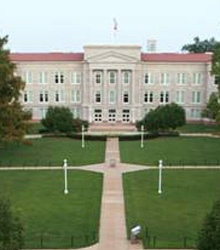
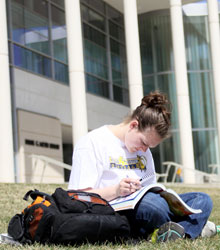 Cooperative doctor of pharmacy degree program
Cooperative doctor of pharmacy degree program